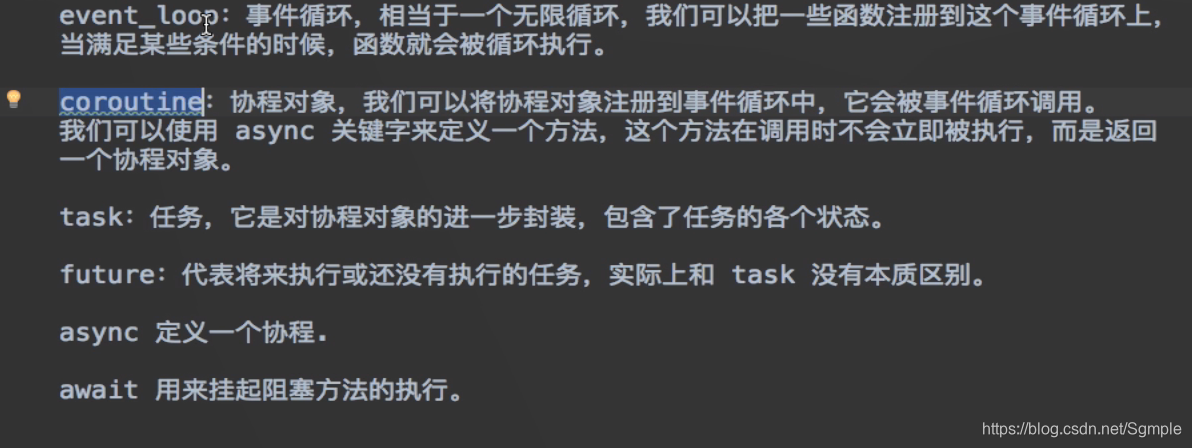目的
在爬虫中使用异步实现高性能的数据爬取
异步爬虫的方式
- 多线程,多进程(不建议)
- 好处:可以为相关阻塞的操作单独开启线程或者进程,阻塞操作就可以异步执行。
- 弊端:无法无限制开启多线程或者多进程。
- 线程池、进程池(适当使用)
- 好处:降低系统对进程或者线程创建和销毁的一个频率,从而很好降低系统的开销
- 弊端:池中线程或进程的数量有上限的。
基本使用:
import time
from multiprocessing.dummy import Pool
def get(str):
print("正在下载:",str)
time.sleep(2)
print("下载成功:",str)
name_list = ['sh','ss','hh','sg']
start_time = time.time()
#实例化一个线程池对象
pool = Pool(4)
#将列表中每一个元素传递给get处理
pool.map(get,name_list)
end_time = time.time()
print(abs(start_time - end_time))
然而,在实际爬虫中并不能把所有的操作都交给线程池处理。
线程池处理的是阻塞且耗时的操作
import requests
from lxml import etree
from multiprocessing.dummy import Pool
import time
def get(url):
print("开始爬取:", url)
time.sleep(1)
print("爬取成功:", url)
if __name__ == "__main__":
ua = "Mozilla/5.0 (Windows NT 10.0; WOW64) AppleWebKit/537.36 (KHTML, like Gecko) Chrome/70.0.3538.25 Safari/537.36 Core/1.70.3775.400 QQBrowser/10.6.4209.400"
headers = {
"User-Agent": ua,
}
url = "https://www.pearvideo.com/category_5"
response = requests.get(url=url, headers=headers).text
tree = etree.HTML(response)
li_list = tree.xpath('//*[@id="categoryList"]/li')
url_2 = []
for li in li_list:
url_2.append("https://www.pearvideo.com/" + li.xpath('//*[@id="categoryList"]/li[1]/div/a/@href')[0])
pool = Pool(9)
pool.map(get , url_2)
- 单线程+异步协程(推荐)

async
用async修饰一个方法,返回一个协程对象
基本使用:
import asyncio
async def request(url):
print("sh")
return url
#asyni修饰的函数,调用之后返回一个对象
c = request(url='www.baidu.com')
#创建一个事件循环对象
# loop = asyncio.get_event_loop()
#
# #将协程对象注册到loop中,然后启动loop
# loop.run_until_complete(c)
#task的使用
#基于loop创建了一个task对象
# loop = asyncio.get_event_loop()
# task = loop.create_task(c)
# print(task)
#
# loop.run_until_complete(task)
# print(task)
#future的使用
# loop = asyncio.get_event_loop()
# task = asyncio.ensure_future(c)
# print(task)
# loop.run_until_complete(task)
# print(task)
#绑定回调
def callback_func(task):
#result返回的就是任务对象中封装的协程对象对应函数的返回值
print(task.result())
loop = asyncio.get_event_loop()
task = asyncio.ensure_future(c)
#添加回调函数
task.add_done_callback(callback_func)
loop.run_until_complete(task)
多任务异步协程
import asyncio
import time
#多任务异步协程
def request(url):
print("正在下载:",url)
#在异步协程中如果出现了同步模块相关的代码,那么就无法实现异步,所以用asyncio使用手动挂起
#time.sleep(2)
await asyncio.sleep(2)
print("下载完毕",url)
urls = ['www.baidu.com','www.4399.com','www.12345.com']
#任务列表需要存放多任务
stasks = []
for url in urls:
c = request(url)
task = asyncio.ensure_future(c)
stasks.append(task)#存放任务
# 开始注册任务
loop = asyncio.get_event_loop()
#需要将任务列表封装到wait中
loop.run_until_complete(asyncio.wait(stasks))
要注意,requests请求是基于同步的,所以需要采用基于异步的网络请求模块进行指定url的指定发送
import requests
from lxml import etree
import time
import asyncio
#使用该模块中的ClientSession对象进行网络请求发送
import aiohttp
async def get(url):
async with aiohttp.ClientSession() as session:
# get(),post()
# headers
async with await session.get(url) as response:
#在获取响应数据操作之前一定要使用await挂起
page_text = await response.text()
print(page_text)
if __name__ == "__main__":
ua = "Mozilla/5.0 (Windows NT 10.0; WOW64) AppleWebKit/537.36 (KHTML, like Gecko) Chrome/70.0.3538.25 Safari/537.36 Core/1.70.3775.400 QQBrowser/10.6.4209.400"
headers = {
"User-Agent": ua,
}
url = "https://www.pearvideo.com/category_5"
#requests用aiohttp替换、
response = requests.get(url=url, headers=headers).text
tree = etree.HTML(response)
li_list = tree.xpath('//*[@id="categoryList"]/li')
tasks = []
for li in li_list:
c = get(url)
task = asyncio.ensure_future(c)
tasks.append(task)
loop = asyncio.get_event_loop()
loop.run_until_complete(asyncio.wait(tasks))